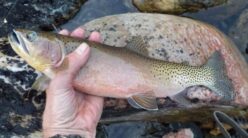The outlook for elk hunting in Idaho for 2018 is fair to excellent with some zones in the central mountains reporting elk populations below objectives. Elk hunting in Idaho is managed in 28 zones.
Hunters can pick up a general A or B tag. The A tag provides more opportunity for archery and muzzle loader hunters and the B tag offers more opportunity for centerfire rifle hunters.
Controlled hunts offer more opportunity for trophy bull hunters, but I believe those tags were given out by mid-July. Check with Idaho Fish and Game in case I'm mistaken.
Elk hunting is a lot of hard work, and preparation is essential to being successful. Hunters can choose one of three methods of hunting elk: purchasing a guided hunt, drop camp hunting or hunting without any assistance.
Guided hunts supply most of what you will need, including horses, tents and a base camp, food for several days, processing of any game harvested, transporting game out of the area to the guide and outfitter's headquarters, etc. The guided hunt is the most expensive, but your guide will know where the elk are and will be able to get you a shot, but you have to make the shot.
Drop camp hunting is usually offered by some guide and outfitters. The guide will drop you off at a camp with tents, but you may have to supply your own food. In this type of hunt, you will be on your own once dropped off and there is no guarantee you will see or get your elk. You may also have to process your own game, so check with the guide and outfitter to be sure what is included and what is not. The guide will check on you and will usually come to pick you up at the end of the hunt. In this type of hunting, you will usually be charged several hundred dollars per horse used to get your hunting party in and out with any game harvested.
Hunting by yourself or with a couple of friends without any assistance is the least expensive way to hunt elk, but make sure you have done your homework and know where to find elk. If you own horses that you can ride and pack game out, you have a real advantage over those who hunt on foot from wherever they leave their vehicles.
Avoid some of the common mistakes elk hunters make that result in coming home without your elk.
Most guides have commented a lot on the sorry state of fitness of some of their clients. Elk live in big, often steep country. Once you see them, you usually will have to get closer to make the shot. You need to close the distance in rough terrain before they decide to go elsewhere. Try to have a fitness regimen that emphasizes cardiovascular and muscle endurance. Stay fit all year long instead of deciding to run and hike a few weeks prior to hunting.
Make sure you can shoot accurately from prone, sitting and off-hand positions. There aren't any benches in the field.
Long-range rifles actually handicap many hunters. Plan on getting closer. It doesn't make sense to zero your rifle at 400 yards and then overshoot your elk at 200 yards. Instead, zero for 200 yards and hold center at 250 yards.
Success in legend areas like the Frank Church River of No Return Wilderness yield about 15 percent success rates, but the scenery is magnificent and that memory may be all you will get to bring home. Choose an area that is hunted less and where you will see elk.
Last, shoot the elk you would be happy to take on the last day as soon as you see it.
Smokey Merkley was raised in Idaho and has been hunting since he was 10 years old. He can be contacted at mokeydo41245@hotmail.com.



